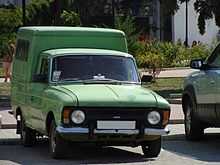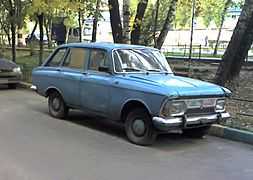Moskvitch 412
| Moskvitch-412/Izh-412 | |
|---|---|
.jpg) | |
| Overview | |
| Manufacturer |
MZMA/AZLK IZh |
| Also called | Moskvitch 1500 SL (export) |
| Production |
|
| Body and chassis | |
| Class | Compact car |
| Body style |
|
| Layout | FR layout |
| Related | Moskvitch 408 |
| Powertrain | |
| Engine | 1478 cc UZAM-412 I4 |
| Dimensions | |
| Wheelbase | 2,400 mm (94.5 in) |
| Length | 4,115 mm (162.0 in) |
| Width | 1,550 mm (61.0 in) |
| Curb weight | 1,045 kg (2,304 lb) |
| Chronology | |
| Predecessor | Moskvitch 403 |
| Successor |
|
The Moskvitch 412 (Moskvich 412, M-412), also called 2140 in 1975 prior to discontinuation and 1500 SL outside USSR, was a small family car produced by Soviet manufacturer MZMA/AZLK from 1967 to 1976. It was also built as the Izh 412 by IZh in Izhevsk from 1967 to 1997 and replaced by the spun off Izh 2125 Kombi series thereafter. The 412, although featuring many flaws gradually fixed with its replacement, was one of the best known third generation Moskvitches and, until 1974, the best selling car in the history of AZLK.
Basically, the Moskvitch 412 was an upgrade of the 408 model in terms of engine features, just as the second generation M-403 was an upgrade of the 402/407. Both cars are often wrongly considered as one chain of succession; in truth, the 412 was in planned development before the 408 production began, simply offering more features to the driver for a higher price. Unlike the 407, the car was made affordable by the absence of concurrency in many Eastern Bloc countries (besides its own relative, the 408).
Design
Upon designing the 1,478 cc (90.2 cu in) DM engine, Moskvitch engineers have likely taken inspiration from the contemporary BMW M 115 engine used in the BMW 1500 model.[2] It is a slanted (to a tilt of 20 degrees) inline-four engine with a block, head, and inlet manifold cast in aluminium [3] (unlike the BMW, which had a cast iron block). Steel cylinder liners were replaceable to enable easy repair of the engine instead of having to replace it entirely. Since it was of an OHC design it was taller than the OHV MZMA-408 engine it replaced, which is why it was mounted at a slant. The same engine was used on Moskvitch cars until the sixth generation (2142).
In 1969 both the 412 and the related 408 had their body and taillights redesigned. These were notable for being the first Moskvitch models to feature square headlights and vertical rear lights and triangular turn signals, which passed on to the 2138/2140 in 1976. Until then, the 412 profited from heightened tailfins and tanned headlight lamps on export models.Front fascia of 412, along with square headlights, were copied from the '1966 Ford Taunus P6 15M. Another notable (but not unique, since it was used in other Russian cars at the time) feature were the so-called side lamps, mounted on the C-pillars on some vehicles (something like the American "opera lights").
It was launched in the United Kingdom in 1969, when the first 20 dealerships were set up and some 300 cars were sold; sales peaked in 1973 when some 14,500 cars were sold through a 268-dealer network. However, sales fell soon afterwards, down to only 3462 in 1973 and 344 in 1975,[4] and the Moskvich was withdrawn from the United Kingdom before the end of the 1970s, by which time it had fallen behind fellow Soviet brand Lada in the sales charts.[5] Satra's 1974 rebranding it the Moskvitch 1500 did not help.[4]

Outside the USSR, the 412 received contradictory reviews. At the time, Soviet automotive industry was mainly focusing on powertrain and speed handling, overlooking such issues as design, seating comfort and safety. Therefore, M-412 was the first Moskvitch to pass safety features tests in France, Bulgaria, Czechoslovakia, and Sweden in 1970—71, and in Germany in 1972, which might have seemed standard for Western car brand-influenced Europe, but was a considerable breakthrough for the Soviet engineers. The design features, however, would not be given consideration for Moskvitch as far as until its fourth generation, the Aleko.
In 1975, it was planned to rename both M-408 and M-412 respectively as M-2138 and M-2140, primarily because AZLK was passing to 4-digit model codes, but also because of an earlier adaptation to the real M-2140, which entered in production starting 1976. Therefore, the only difference between this model and its successor, at the time, was the engine change.
Satra entered 412s in the Group One Production Saloon Car Championship in 1972 and 1973, and it beat "sharp-handling but underpowered" Hillman Imps and Austin Minis.[6] It also placed 1-2-3 in the 1973 Avon Round Britain Rally[6] and scored a class win in the South Africa Safari Rally the same year.[7]
Trims and models
Moskvitch
- M-412 was the base sedan model that underwent various adaptations with letters such as "E", "I", "U", "P", etc. added after its numbers. Letters usually meant the class of the vehicle (as in luxury residential, commercial, governmental, sports, export, and so on) instead of precising words used on earlier models. Kerb weight of the 412 was 1,045 kg (2,304 lb).[8]
- М-427, a station wagon on the same base, produced from 1969, replacing the M-426 wagon. In 1972, this got a new one-piece upward-hinged tailgate.[7] AZLK stopped making these in 1976; IZh continued with production until 1982. Starting 1971, the base of this model served to create the Izh-2125 hatchback (see below).
- M-434, which was the unibody sedan delivery and pickup[9] variant that succeeded the 433 straight from 1967 to 1973 (thereafter it was replaced by the Izh-2715 that increased in popularity by that time). Both this model and M-427 kept their rear light tailfin design until 1982, and passed it on to M-2137 variants from 1975.
Izh

- Izh-412 — practically similar to M-412, with slight changes in the frontal grille (featuring design elements from earlier M-408). Since IZH stopped delivering the Izh-408s in 1967, last production Izh-408 lines were also named "Izh-412" for convenience.
- Izh-427 was a calque of the M-427, with no other changes beside the company logo. The car, however, entered in production only in 1971 because of the abundance in Moskvitch variants.
- Izh-2125 — surnamed "Kombi", was the first Soviet hatchback series produced from 1973 to 1982, before receiving the Moskvitch 2140 platform as Izh-21251. It was then kept in production until 1997.
- Izh-2715 was IZH's panel van variant, also produced from 1973 and commonly referred to as a "covered pick-up". Izh kept this variant from 1982 till 2001,and stylistically improved it, maximally approaching the Kombi.
Relationship to M-408

The original 412 of 1967-69 had a chassis identical to that of the Moskvitch 408, which had been launched 3 years earlier in 1964. The only differences between 408 and 412 were the engines and the interior. This can be confusing, because there are no external differences between the two cars.
Here are the main differences between the Moskvitch 412 and the Moskvitch 408:
| Moskvitch 412 | Moskvitch 408 | |
|---|---|---|
| Production | 1967–1976 | 1964–1976 |
| Engine model | 412 | 408 |
| Chassis | 408 (1967–1969); 412 (1969–1976) | 408 (1964–1969); 412 (1969–1970) |
| Successor | Moskvitch 2140 | Moskvitch 2138 |
The differences between the 412/408 chassis:
| 1969 - 1975 | 1967 - 1969 | |
|---|---|---|
| Features | Square headlights; horizontal rear lights; triangular rear turn signal markers; separated front seats; floor mounted gearshift lever (except for the 408 which had column-mounted shifter until 1973). | 2 or 4 (twin) round headlights (Izh-412: 1967 - 1982); vertical rear lights; front bench seat (until 1968); column mounted gearshift lever (on the 408 until 1973, on the 412 until the fall of 1968). |
Prototype variants
In 1970, Moskvitch tried to update the 412's styling, with the 353. Using the 412's mechanicals, it was larger but recognizably related. The 355 of 1972 was larger still, with 23 cm (9.1 in) greater length, 14 cm (5.5 in) more wheelbase, and 8 cm (3.1 in) more width.[10] This made both the interior and the boot noticeably larger.[10] The 355 was further developed into the 356 between 1973–75, with "much bolder front end styling", new suspension, and an enlarged 1,799 cc (109.8 cu in) version of the DM with twin Zenith carburetors, giving 103 hp (77 kW; 104 PS), with a Borg-Warner transmission planned.[10] None were built.
Grilles
-

Restyled M-412 grille used from 1969 to 1975, also featured on M-408 during the same years.
-

Upmarket "tanned" grille, used mainly on export models.
-

M-426 estate model used the new grille from 1969, though ithe car itself still featured M-408 engine.
-

Similar grille featured on the 1973—82 "Kombi", based on M-412. Turn lights were moved up.
-

M-2138/40 grille, appearing shortly before the discontinuation of M-412 in late 1975.
References
- ↑ Moskvich - The Son of Moscow, www.ucapusa.com Retrieved 26 January 2014
- ↑ Thompson, Andy (2008), Cars of the Soviet Union: The Definite History, Sparkford, Yeovil, Somerset: Haynes, p. 149, ISBN 978 1 84425 483 5
- ↑ Braunschweig, Robert et al., eds. (12 March 1970). "Automobil Revue '70" (in German/French) 65. Berne, Switzerland: Hallwag AG. p. 413.
- ↑ 4.0 4.1 Thompson, p.162.
- ↑
- ↑ 6.0 6.1 Thompson, p.160.
- ↑ 7.0 7.1 Thompson, p.163.
- ↑ Thompson, p. 152.
- ↑ Thompson, p. 159.
- ↑ 10.0 10.1 10.2 Thompson, p. 164.
| Wikimedia Commons has media related to Moskvich 412. |
